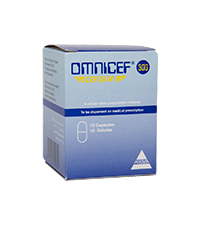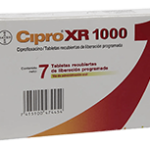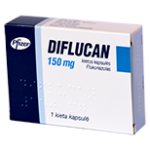
Omnicef

What is Omnicef?
Omnicef (cefdinir) is used to treat certain bacterial infections, for example pneumonia, bronchitis, ear infections, sinusitis, pharyngitis, tonsillitis and skin infections. Cefdinir is a cephalosporin. It works by inhibiting the synthesis of the cell wall of bacteria.
Mechanism of action

Cephalosporins, the class of drugs where Omnicef belongs, have natural origins. Cephalosporin C – the progenitor of this class of antibiotics – was isolated from the mycete Cephalosporium acremonium.
Omnicef acts by inhibiting the synthesis of the bacterial cell wall, in particular the peptidoglycan. Peptidoglycan is a polymer made up of parallel chains of nitrogenous carbohydrates, joined together by transverse bonds.
Omnicef binds to transammidase, the enzyme involved in the formation of the above transverse bonds. The cephalosporin-transammidase interaction prevents the formation of these bonds, thus generating weak areas within the peptidoglycanic structure that lead to cell lysis and the consequent death of the bacterial cell.
Omnicef dosage
The dosage regimen is set individually depending on the age, body weight, renal function of the patient and the severity of the infection. For adults, the daily dose for all infectious diseases is 600 mg in a single dose or in two separate doses.
Dosing the drug once a day for 10 days is as effective as taking Omnicef twice a day. Dosing capsules once a day has not been studied for pneumonia and skin infections, so the twice a day approach should not be practiced for these conditions.
Omnicef can be taken regardless of the meals. The course duration is 5 to 10 days. Cefdinir as a suspension is recommended for children (age from 6 months up to 12 years old).
How to use Omnicef experiencing beneficial reactions only?
Cefdinir is administered orally, usually in the form of capsules or suspension. Usually the dosage is two intakes per day, preferably with food or milk to avoid possible stomach discomfort.
Omnicef for treating UTI
Omnicef is used to treat the following UTI infections:
- Simple acute cystitis
- Patients receiving NSAIDs (increased risk of convulsions)
- Complicated cystitis
- Recurrent cystitis
- Acute pyelonephritis
- Acute prostatitis
Omnicef used in male population with UTI:
In men, chronic bacterial prostatitis without classic prostate symptoms is a common cause of recurrent UTI in men. Infection episodes are usually caused by the same bacterial strain, indicating the presence of chronic urinary tract infection. Bacteria are found in biofilms and calcifications in the prostate and are thereby protected against both the infection defense and the effect of antibiotics, which means that they cannot be eliminated. These bacteria are susceptible to Omnicef effects.
Omnicef used in female population with UTI:
Bacteria that cause UTI in women originate from the gut and sometimes colonize the vaginal and periurethral microflora. Via the woman’s short urethra, they can then easily enter the lower urinary tract. Repeated antibiotic therapy courses affect both the intestinal and vaginal flora. Antibiotic-resistant uropathogenic bacteria are selected in the gut and changes in the vaginal microenvironment make the bacteria colonize the periurethral region. The risk of negative ecological effects varies for different antibiotics.
Omnicef used in pediatric population with UTI:
Urinary tract infection (UTI) is one of the most common bacterial infections in children, many of which are already affected during infancy. A high level of attention for UTI is therefore necessary, especially in the small children. The gender distribution is even the first year of life, but then UTI is much more unusual in boys. There is a risk for both under- and over-diagnosis. For a safe diagnosis, adequate urine samples are required. The risk of permanent kidney damage increases significantly with delayed or missed detection of pyelonephritis.
Studies based on Omnicef and urethral problems
According to this study, the use of cefotaxime has demonstrated high clinical efficacy and tolerance in patients with UTI infections. Based on the drug’s bactericidal action of wide spectrum and sensitivity of most multiresistant pathogens (save for enterococci) towards the drug, Omnicef is indicated in the majority of UTI across different populations of patients.
Omnicef and allergy
During the use of Omnicef, the following may occur:
- allergic reactions. Before starting treatment with this medicine, your doctor will perform specific tests to make sure you are not allergic to cefotaxime, cephalosporins, penicillins or other medicines. Use this medicine with caution and tell your doctor if you have ever experienced an allergy, especially to penicillins (beta-lactam antibiotics). If you notice an allergic reaction, stop using this medicine and tell your doctor immediately, or contact your nearest hospital: a doctor, depending on your condition, will establish the appropriate treatment;
- appearance of blisters on the skin (severe bullous eruptions such as Stevens-Johnson syndrome or toxic epidermal necrolysis). If you notice any skin or mucosal reactions, with blisters or blisters, stop the treatment and contact your doctor immediately.
Precautions
In case of treatment with antacids based on magnesium or aluminum or with products containing iron it is good to take them at least two hours away from cefdinir (before or after).
Contraindications
Omnicef is not recommended in people with kidney failure, should be avoided in case of pregnancy, known hypersensitivity to the drug or in cases of penicillin allergy and presence of colitis or seizures.
Side effects

Possible adverse effects of Omnicef include:
- upset stomach
- vomiting
- loss of appetite
- diarrhea
- headache
- dizziness
- fatigue
You should contact a doctor immediately if you develop:
- rash
- urticaria
- itch
- breathing difficulties
- tightness in the chest
- swelling of the mouth, face, lips or tongue
- difficulty swallowing
- vaginal infections
Omnicef and alcohol
The frequent prescription of antibiotic therapy makes pertinent the question of the observance of the use of antibiotics. Many do not go to the doctor for advice and begin to treat the infection alone with apparently safe penicillins and cephalosporins. However, antibiotics have a significant effect on the body without visible initial effects. The understatement of their value is manifested by intestinal dysbiosis, pathology of the immune system and other organs.
When undergoing the treatment with drugs of this group, it is recommended to use the prescribed dose in a timely manner, follow a special diet and eliminate alcohol. The reason for the alcohol ban at the time of treatment concerns many.
Scientific arguments suggest that danger exists. Cephalosporins, the class of drugs to which Omnicef belongs, interact with alcohol. The clinical data is limited; it is therefore not recommended to mix alcohol and Omnicef, since possible health risks cannot be clearly estimated or predicted.
Omnicef analogs:
- Kefnir – Glenmark – Pharmaceuticals Ltd. (Majesta)
- Maxicef –O – Aristo Pharmaceuticals Pvt. Ltd.
- Idinir -300 – Invision Medi Sciences Pvt. Ltd.
- Cendir Nicholas – Piramal India Ltd.
- Cednir Nicholas – Piramal India Ltd.
Posted in Antibiotics
(0 voices, average: 5 of 5) 3664 views





















